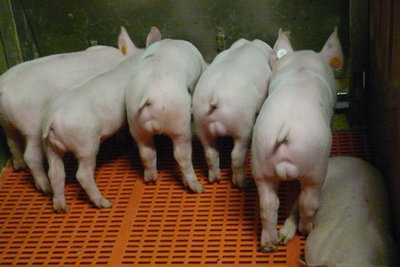What is boar taint and when does it occur?
Boar taint is an off-odour which is present when heating meat or fat from boars (entire male pigs). This off-odour may impair consumer acceptance. Based on studies performed by ILVO, average boar taint prevalence in Belgium seems to be around 3 to 5%, but this prevalence varies between farms and slaughter events. Boar taint is mainly caused by androstenone and skatole. Androstenone has a urine-like or sweaty odour and is produced in the testes. Skatole is produced by microbes in the hindgut. The odour of skatole has been described as faecal-like, naphthalene, sweet, warm, and fruity. While almost all consumers can smell skatole, only half of them are able to perceive androstenone.
Boars are therefore castrated in most countries before the age of 7 days. Surgical castration is effective to reduce boar taint and also to ease pig management by preventing the development of male sex characteristics. However, the traditional procedure is painful and social pressure to abandon surgical castration is high.
What is the situation in the sector?
Several main actors in the pig meat chain agreed on a plan to voluntarily end the surgical castration of pigs in the EU by January 1, 2018 (Declaration of Brussels, EU Commission) under the premise that alternatives are economically feasible. However, this is not yet the case.
For pig producers, production of boars can result in a higher income due to the better feed conversion ratio and higher lean meat percentage of boars compared to barrows (castrated male pigs). A major concern for the farmers, however, is the current lack of market opportunities for boars.
The meat industry and retail remain reluctant to accept meat from boars. One of the main reasons for this is the lack of a method to detect boar taint at the slaughter line. Currently the evaluation is done by well-trained experts at slaughter line. It is the best possible method, but it is subjective and difficult to harmonise, and therefore not generally accepted. Boar taint prevalence should also be reduced for raising boars to be an economically viable alternative.
Possible solutions and the role of IoT?
Selection against boar taint is being investigated as a long-term solution. In the short-term, research focuses on the reduction of boar taint by adaptation of management: Feed ingredients (e.g. inulin, chicory roots, raw potato starch), breed and slaughter weight. However, a complete elimination of boar taint with these management strategies is difficult.
Information on the effect of farm-related factors such as breed, health status, housing, feed composition, age or duration of fasting are mostly insufficient. Results on boar taint prevalence are also not linked to slaughter related data such as season, temperature, transport duration, carcass weight and lean meat percentage.
The Pig farm management case of the IoF2020 project aims to reach a better understanding of important factors that can be linked with boar taint prevalence in order to provide farms with specific strategies to reduce it. This evaluation not only can help farmers to reduce boar taint, but also has a lot of potential to support the making of other management decisions.
